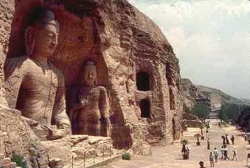The Spread of Buddhism along the Silk Road
A most significant development happened at the same time asthe Buddhist movement began to spread and that was the opening ofa new way through, from India to China. Today, we call this way "the Silk Road", and weassociate it with famous travellers like Marco Polo, whosejourneys to China astounded the Europeans of his day. The route was first established by the Chinese, venturing outin search of horses and trade, and it dates back to the secondcentury BC. From that time, it became a regular journey fortraders seeking to make a small fortune. In the followingcenturies, the route fell under control of different politicalgroups, but was always well used until the 15th century AD whensea trade dominated.
From early days, silk was exported from China to Italy whereit became immensely popular. Grapes and wine making were soonintroduced to the East as well as perfumes, spices, unknownanimals and birds such as peacocks. From China, we firstencountered roses, oranges and pears. There was considerable costto transport all these items, but the profits were huge forsuccessful traders. The Silk Road began near Iran and India, went south of theCaspian Sea, and then took one of two routes, along the bordersof the Taklamakan desert. The two routes joined in North WesternChina.
The route was treacherous and crossed huge deserts, as well asdifficult mountain passes and steep valleys. A well organisedexpedition relied on camels and good knowledge of local wateringholes. Bandits were common and many traders perished on thejourney.
From about the first century BC, Buddhism began its spreadalong the Silk Road. As it travelled and was accepted, wholecommunities took the message on board and monks lived along theway. Many ruins exist in the desert regions where numerous finelydecorated caves formed the centre of whole monasteries. Someareas have up to a thousand caves in a single group. Many of thesecaves had beautiful wall paintings and Buddha images which oftenwere sponsored by travellers who sought protection for theirjourney ahead or gave thanks for having made it that far. In the middle of the first century AD, a Han Chinese Emperorbecame interested in Buddhism. He sent envoys to India and in67AD they returned with Buddhist writings. He then proceeded tohave these texts translated into Chinese.
"According to legend, the Han Emperor Mingti, who had already heard of Buddhism, dreamt of a golden figure floating in a halo of light - that was interpreted by the Emperor’s wise men to be the Buddha himself. Consequently, an envoy was sent to India to learn about the new religion, returning with sacred Buddhist texts and paintings as well as Indian priests to explain the teaching of the Buddha to the Emperor. Monks, missionaries and pilgrims began travelling from India to Central Asia and then on to China, bringing Buddhist writings and paintings, while converts followed the Silk Road West." From the web site on China Pages/Chinese Culture/The Silk Road. In the north western part of China the majority of thepopulation was Buddhist by the late fourth century and Buddhismwas well supported by the ruling classes. Buddhist monks also travelled with the traders along the wayand soon Buddhist monasteries were everywhere along the routebetween India and China. The monasteries were used by travellersas safe places to rest overnight, and sometimes for longerperiods to recuperate from an illness. Donations were generouslygiven and the monasteries flourished. In Western countries, the skill of producing silk remainedlargely unknown until the 12th century however once this changed,the route began to lose its major significance. With the spreadof Islam into the regions around the Silk Road, many of thestupas and temples were destroyed or left abandoned in thedesert.
Spread of Buddhism
After spreading to China, the Ch’an school of Buddhismdeveloped and this later became the Zen School of Japan. This interpretation of Buddhism is today almost non-existent in itsfounding country. The need to spread texts contributed to thedevelopment of block printing techniques in China. The Pure LandSchool also began in China before moving into Japan and Korea. In 845, foreign religions were banned in China and apersecution of Buddhist groups greatly reduced numbers. This wasfollowed by the political climate of the 20th Century whichdiscouraged most religious activities. Although China passed on the Buddhist message, the Buddhistphilosophy almost disappeared in China and was to be found insmall pockets often around existing temples, and only recentlyhas there been a reversal of this trend. From China, Buddhism spread into Korea in the fourth centuryAD and soon after into Japan. Tibet was one of the last countriesto accept the Buddhist message. While it was introduced there inabout 609AD, it was not widely accepted until the 11th centuryAD.
Further Spread of Theravada Buddhism
While the Mahayana school of Buddhism spread north, along theSilk Road to China, Korea, Japan and Tibet, the Theravada schoollost ground in the early years because the main financial supportwas for the Mahayana expeditions. From India, Buddhism first went to Bengal and then Sri Lanka early in the thirdCentury BC. Sri Lanka became strongly Buddhist and followed the Theravada model. It was here that many of the early teachingswere finally written down. From Sri Lanka, monks went to Burma in the 5th Century but itwas not until the 12th Century AD that Buddhism became widelyestablished. Thailand took on Buddhism in the 13th Century AD,with Laos and Cambodia also taking on the teaching soon after,all following the Theravada school. At the same time, by the15th Century, Buddhism had virtually disappeared from India, andhas never been a major influence there ever since, although therehave been some revival in particular areas.
Source
www.buddha101.com [[Category:Silk Road]]

